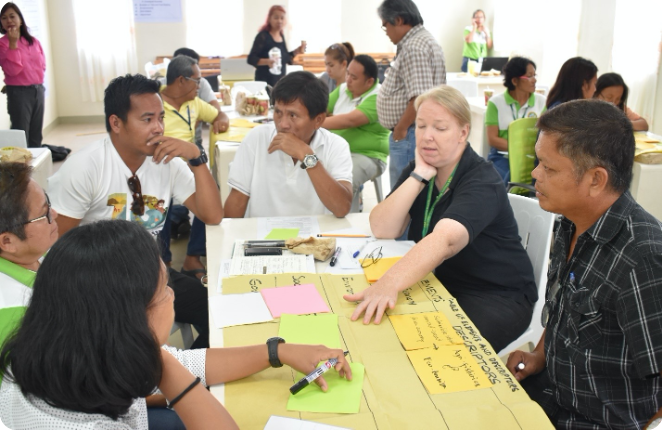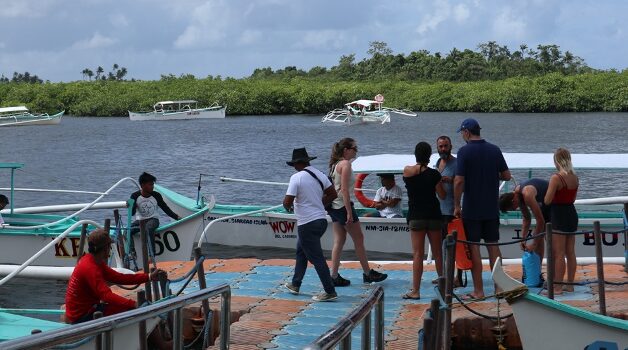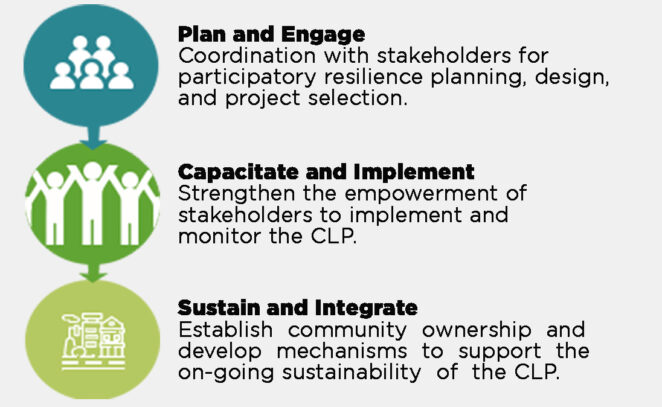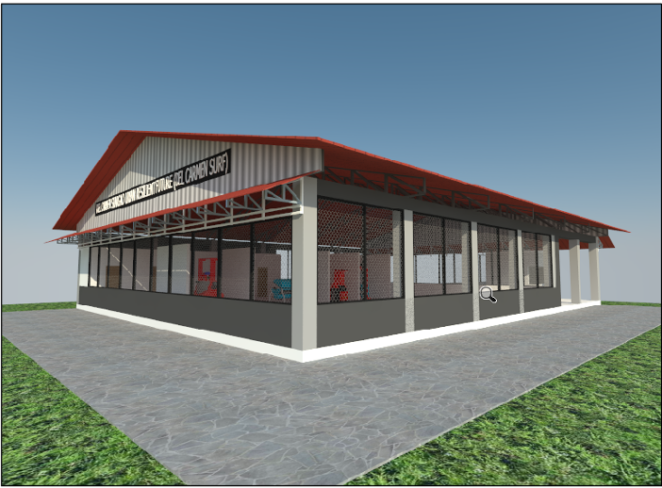Siargao Urban Resilient Future (Del Carmen SURF) Project

Introduction
Del Carmen, a municipality inSiargao Island, Surigao del Norte is experiencingarapid influx of migrants, tourists, and commercial establishments.This hascreated serious solid waste management challenges which areadversely affecting the quality of life oflocal communities.The current waste collection rate in the municipality is about 10%,anduncontrolleddumpsites and illegal waste disposal practices have proliferated, damaging the marine and island environment (Municipality of Del Carmen, 2016).

Local communities and the environment are already being stressed by climate change e.g. rising temperatures and saltwater intrusionhave reduced agricultural production and damaged livelihood opportunities. Futureclimatescenarios from the Philippine Atmospheric, Geophysical and Astronomical Services Administration (PAGASA) project an increaseof between 0.9oC to 2.1oCin mean temperaturesduring the island’s dry season.Biodiversity, themarine ecosystem, agriculture production and fishing,water supply and public health will be increasingly stressed by climate change.Higher temperatures will hasten waste decomposition andwill affect local communities, destroying the aesthetics of their island community and increasinghealth risks.Climate change impacts and uncontrolled solid waste management is and will become an ever-increasing toxic mix for communities and the environment.

This project page presents the“Siargao Urban Resilient Future (Del Carmen SURF)” project, which aims to improve the resilience of the community by strengthening its solid waste management system.
Methodology
The community-led project (CLP) places urban poor communities as activeand informedparticipantsat the centre of the process of resilience planning, from assessment to implementation,andgives them a role in themaintenance of CLPs.Through the Community Resilience Planning (CRP) process,people frompoor and vulnerablegroups work together with other stakeholders from government and the private sector to collect and analyse data about how hazards impact vulnerable groups and livelihoodsanddesignand agreeresilience solutions. The CRP process requires strong social mobilization, communication and engagementwith all stakeholders. It also requires the creation of the Community Stakeholder Group (CSG), an institutional and multi-sectoral mechanism for transparent and effective information sharing, decision-making and implementation of community decisions and actions.

Community-Led Resilience Project
Through the Community Resilience Planning process, Del Carmen community stakeholders identified and developed thecommunity-led project called “Siargao Urban Resilient Future (Del Carmen SURF)” which aims to improve the resilience of the community by strengthening its solid waste management system. The project will establish acommunity-basedwaste recovery and recycling center and implement solid waste management technologies.

Innovations
Del Carmen SURF is the very first waste recovery and recycling facility in the island ofSiargao. The Waste Recovery and Recycling Program is a community-managed recovery and recycling system centered around a Material Recovery Facility (MRF)where biodegradable waste materialsare processedinto compost fertilizer; recyclable plastic materials are recovered, recycled or sold; and residual wastes are processed and meltedto form recycled bricks and construction materials (Asian Development Bank, 2013).

Gender and Social Inclusion
Women and youth groupsareinvolved in project development and implementation.Community-based solid waste management is driven by strong volunteerism, but the burden of volunteering falls on women.This assumes women have time, however to volunteer they transfer unpaid care and household work to other women (e.g. the eldest daughter or grandmother). Transferring home care work to other women affects their productivity, time for education, self-care and enterprise. Women working in waste separation, waste collection promotion and other waste management activities should get paid for doing work and the time they invest should be properly acknowledged.The provision of child-minding facilities in recycling centers can help women in their child-minding duties making it less worrisome to do solid waste management work while taking care of toddlers. Also, the youth have expressedtheircommitmentto marketing the recycled products throughsocial media.
Issues and Challenges
The implementation of theCLPrequires addressingseveral challenges including theneed to strengthen thecommunity’s technical and operational capacity to manage and maintain the waste recovery and recycling center, andmarket the composts and recycled products. TheCSG willneed todevelop linkages withtheprivate sector toimprove waste recovery value chains. New livelihoods will need to be created to support the recovery andrecycling of wastes.The municipality will alsoneed tocontribute to financing the project’s operations and maintenance cost by securing institutional funding throughthe local government budget.
Expected Results and Impact of the Project
The projectaims to address the waste management needs of its burgeoning tourism and commercial industry.The fully functional solid waste management facility will significantly increase waste management in Del Carmen from the current 10% total waste collection rate to potential waste recovery rate of up to 87% at full project implementation. This in effect will decrease the amount of trash regularly shipped fromSiargao Island to mainland Mindanao which carries inherent risks of polluting the marine environment. It will also reduce unsustainable waste management practices in the community.The facilitywill (1) reduce the volume of wastes disposed of by the community, (2) reduce the budget for urban services allocated by the local government for community waste management and inter-island hauling of wastes, (3) reduce the incidence of illegal waste disposal e.g. illegal dumpsites, garbage burning and disposal into bodies of water in the community, (4) reduce adverse environmental impacts ofimproper waste management such as marine pollution, air pollution and methane emission, and (5) generate green jobs and livelihoods especially forpoor people who are now dependent on theinformal sector.
The project is alsoexploringa ‘’pay as you throw’’ (PAYT) scheme for the growing number of tourism-based businesses in the central business district, such as restaurants, bars, souvenir shops and stores. The waste recovery and recycling center is expected to bring in revenue from solid waste collection service fees and income fromthesale of recyclable waste and recycled products.It is intended that this revenuewillcoveron-goingoperational and maintenancecosts.Finally, the system can be replicated by other municipalitieson the island, and in the province of Surigao del Norte.

The project is still ongoing and is funded and supported by the Asian development bank through the Urban Climate Change Resilience Trust Fund (ADB-UCCRTF) and implementedby Oxfam in partnership with the Philippine Rural Reconstruction Movement (PRRM).
About UCCRTF. The Urban Climate Change Resilience Trust Fund is a $150 million multi-donor trust fund (2013-2021) administered by the Asian Development Bank under the Urban Financing Partnership Facility. With funding from the Rockefeller Foundation and the Governments of Switzerland and the United Kingdom, it aims to support fast-growing cities in Asia to reduce the risks poor and vulnerable people face from floods, storms or droughts, by helping to better plan and design infrastructure to invest against these impacts.
ADB-RETA 9329. Oxfam and local partner Philippine Rural Reconstruction Movement is implementing ADB-RETA 9329 Promoting Urban Climate Change Resilience in Selected Asian Cities Subproject 3 (SP3): Pilot and Project Development Activities. The goal of the project is to contribute to climate change resilience by empowering vulnerable communities through community-led initiatives. The project is implemented in 9 pilot communities in Bangladesh, Pakistan, Philippines and Myanmar.
Contact details
Dr. Virinder Sharma
Senior Urban Development Specialist
Asian Development Bank
Sharon Taylor
Project Manager (Philippines)
Philippine Rural Reconstruction Movement
Jose Arianne Gonzales
Communications and Knowledge Management Specialist
Oxfam Great Britain
[email protected]
Citation
Jeans, H., Deocariza, M., Gonzalez, J.A., Taylor, S. and Perocho, M. (2021) Siargao Urban Resilient Future (Del Carmen SURF) Project. On weADAPT, the Collaborative Platform on Climate Change Adaptation.
Further readings
Related resources
- Asian Development Bank (2013). Materials recovery facility tool kit.
- Communities lead the way in creating a more resilient Siargao Island
- Improved Waste Management through Public-Private Partnerships in Lusaka
- Community-Managed Water Supply System and Rainwater Harvesting Facility
- Building Resilience to Floods and Rain-Induced Landslides in Barangay Napaan
- Climate Resilient Community-Managed Flood Mitigation Project in La Trinidad, Benguet
(0) Comments
There is no content